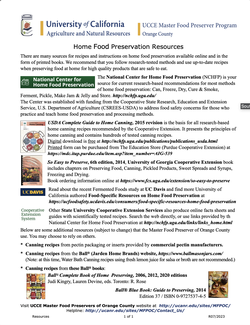Food Preservation Resources
Some Home Food Preservation Resources used by UC Master Food Preservers in Orange County

The National Center for Home Food Preservation (NCHFP) is your source for current research-based recommendations for most methods of home food preservation: Can, Freeze, Dry, Cure & Smoke, Ferment, Pickle, Make Jam & Jelly and Store. http://nchfp.uga.edu/
The Center was established with funding from the Cooperative State Research, Education and Extension Service, U.S. Department of Agriculture (CSREES-USDA) to address food safety concerns for those who practice and teach home food preservation and processing methods.
USDA Complete Guide to Home Canning, 2015 revision is the basis for all research-based home canning recipes recommended by the Cooperative Extension. It presents the principles of home canning and contains hundreds of tested canning recipes. Digital download is free at http://nchfp.uga.edu/publications/publications_usda.html
Printed form can be purchased from The Education Store (Purdue Cooperative Extension) at https://mdc.itap.purdue.edu/item.asp?item_number=AIG-539
So Easy to Preserve, 6th edition, 2014, University of Georgia Cooperative Extension book includes chapters on Preserving Food, Canning, Pickled Products, Sweet Spreads and Syrups, Freezing and Drying.
Book ordering information online at https://www.fcs.uga.edu/extension/so-easy-to-preserve
Read about the recent Fermented Foods study at UC Davis and find more University of California authored Food-Specific Resources on Home Food Preservation at https://ucfoodsafety.ucdavis.edu/consumers/food-specific-resources-home-food-preservation
Other State University Cooperative Extension Services also produce online facts sheets and guides with scientifically tested recipes. Search the web directly, or use links provided by th National Center for Home Food Preservation at http://nchfp.uga.edu/links/links_home.html
Below are some additional resources (subject to change) that the Master Food Preserver of Orange County use. You may choose to rely on others.
* Canning recipes included with pectin packaged by commercial pectin manufacturers.
* Canning recipes from the Ball® (Jarden Home Brands) website, https://www.ballmasonjars.com/
(Note: at this time, Water Bath Canning recipes using fresh lemon juice for salsa or broth are not recommended.)
* Canning recipes from
- Ball® Complete Book of Home Preserving, 2006, 2012, 2020 editions Judi Kingry, Lauren Devine, eds. Toronto: R. Rose
- Ball® Blue Book: Guide to Preserving, 2014 Edition 37 / ISBN 0-9727537-4-5
More Information
Storing Foods:
Storing Fresh Fruits & Vegetables for Better Taste (UC Davis 21590)
Miscellaneous:
There is an abundance of information available on food safety and preservation. The UC Master Food Preservers have assembled collections of resources to facilitate your search for research-based recipes and preservation information including publications or videos from University Extension programs nationwide and more.
For example, if you wanted to learn more about Drying/Dehydrating fruits and vegetables, among the documents you would find listed in the publications library, under dehydrate are
Drying Fruits and Vegetables (University of Georgia Extension)
Drying Fruits and Vegetables (Pacific Northwest Extension Publication PNW397).
